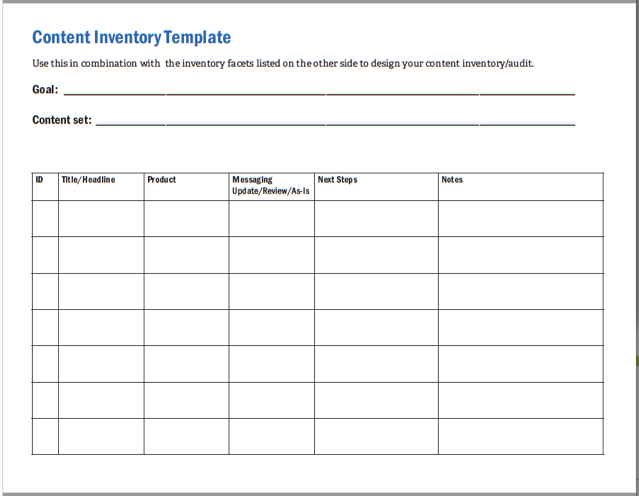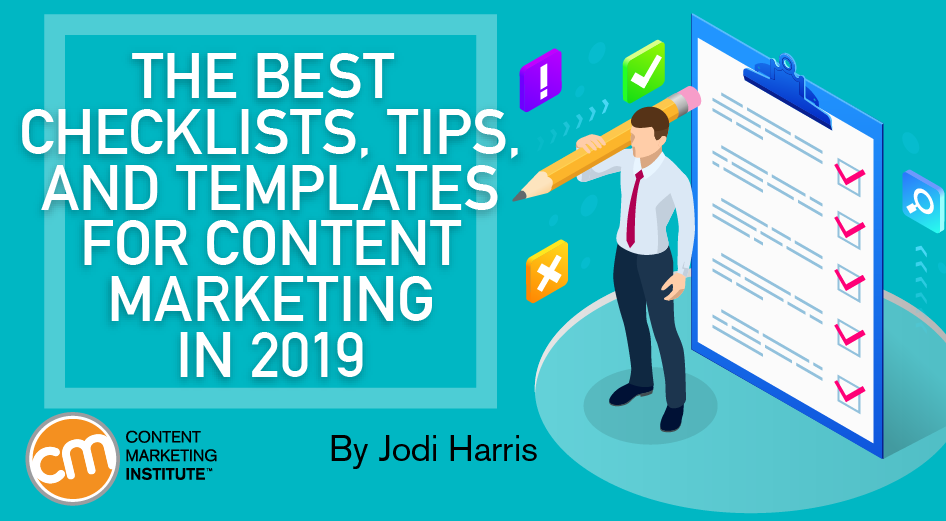Craft a one-page content strategy guide You can’t achieve content marketing success unless you understand what success means to your organization. Some of the most common goals marketers pursue through their content programs include: Of course, content marketing can help your business achieve all these aims and more; but it works best when you focus on one challenge at a time. To figure out which goals your organization should prioritize, try the steps in George Stenitzer’s one-page strategy guide. Take the information you gathered through these steps and assemble your audience persona profile. For more comprehensive guidance on strategic considerations, follow the Road Map to Success: Content Marketing Strategy Essentials Content planning tips and tools Repeat after me: “Content marketing works best when you plan for its success.” You need an operational plan that outlines all the insights, actions, people, and procedures necessary to take your content marketing program from a lofty strategic ideal to a fully functional and productive content marketing engine. Staff up with the right content marketing skills To consistently produce high-quality content on multiple channels and platforms, you need to make sure everyone on your team understands your organization’s expectations and has the required skills and know-how to fulfill them. Finding a writer who is the right fit for your team and your tasks can take some time – and a lot of careful vetting. For more comprehensive guidance on processes and teams, follow the Road Map to Success: Turn Your Strategy Into a Stellar Editorial Plan Content creation tips and tools Once you’ve set your strategy and outlined your plans for executing it, it’s time to create high-quality, customer-driven stories. Though the creative process is unique to every business, plenty of tools can help with generating story ideas, organizing them into relevant content pieces, and getting them into the hands of your target audience. But one thing that can make your decisions more straightforward is establishing a channel plan – an advanced directive for how your brand can and should distribute its content marketing efforts on rented channels like social media and what you expect to achieve.

Have you developed your foolproof plan for getting Alexa, Siri, Cortana, or Google Home devices to speak your brand’s praises when customers come calling for advice?
Are you fighting FOMO with a killer virtual reality app that turns your shopping experience into a garden of unearthly delights for consumers to explore?
Have you budgeted for a new blockchain-based loyalty program or a celebrity-hosted influencer network promising fame and fortune to your audience in exchange for their ongoing engagement?
Don’t panic about keeping up with progressive content trends like these. Remember while it’s tempting to pour all your content team’s energies and resources into the next big thing to hit the digital marketplace, sustainable, long-term success with content marketing first requires a mastery of the fundamentals.
This updated toolkit – featuring some of CMI’s best tips, checklists, and templates – can help you build that solid foundation. Use it to check off some of the critical content marketing tasks on your to-do list more efficiently and use the newly freed brainpower to innovate wisely and purposefully.
Content marketing strategy tips and tools
Everything you do as a content marketer should flow from a deliberately constructed content marketing strategy. This includes determining how to model your content operations as well as outlining why you are creating content (your purpose), who you want it to reach (your audience), and the expected impact of your content efforts on the business (your goals).
Choose a content business model
Think of your strategy as a road map of the content experience you intend to cultivate and how it will connect your business with your audience – and move both of you closer to achieving your goals.
Of course, anyone who has used Google Maps knows that every destination has multiple routes. And, according to CMI’s chief strategy advisor Robert Rose, the same goes for finding the best content marketing strategy for your organization. In fact, he recently identified four viable approaches that organizations can follow based on their goals, business structure, team resources, and level of content experience:
- Player: Content marketing is seen as a contributor to other business communication strategies such as demand generation or product marketing.
- Performer: Content functions as a center of excellence, aiming to build an addressable audience through owned media platforms.
- Processor: Content is treated as a centralized service offered throughout the organization.
- Platform: Content is run as a self-sufficient yet fully integrated media business.

Craft a one-page content strategy guide
You can’t achieve content marketing success unless you understand what success means to your organization. Some of the most common goals marketers pursue through their content programs include:
Of course, content marketing can help your business achieve all these aims and more; but it works best when you focus on one challenge at a time. If your content program could only help your company achieve a single goal, what would you want it to be?
To figure out which goals your organization should prioritize, try the steps in George Stenitzer’s one-page strategy guide.
Build performance-driven audience personas
When you think of your content recipients in broad terms like “audience” or “targets,” it’s easy to lose sight of their needs as unique, complex people with different needs, interests, preferences, and behaviors.
That’s where audience personas come into play. These composite sketches help characterize key segments of your audience in terms of their relevant challenges and concerns and the role they likely play in their company’s purchasing process.
Robert suggests this five-step approach to building more valuable audience personas – ones that put the customer’s needs at the center of your stories:
- Define your target: Detail the total addressable audience.
- Discover the “so I can”: Uncover the functional and emotional jobs the audience needs to get done.
- Decide on your niche: Find your sweet spot of relevance – where your field of knowledge and your skill sets intersect with a passion point of your audience.
- Differentiate your content approach: Prioritize the jobs to be done by those that you can and should solve with your unique and distinct point of view.
- Design your map of success: Identify as many of the kinds of value you can provide across each step of your chosen jobs to be done.
Take the information you gathered through these steps and assemble your audience persona profile. Here’s Robert’s example:

Write a content marketing mission statement
A unique content marketing mission statement helps you document your company’s reason for creating content and the priorities and perspectives it will uphold in pursuit of that mission.
Your mission statement is a critical component for guiding decision-making throughout the life of your program. As Ann Gynn points out, there’s an art to crafting a useful one – and not everyone gets it right. To avoid providing too much (or too little) detail in your statement, follow these tips:
- Be succinct but don’t oversimplify: Describe your editorial mission clearly to prevent your content team and your readers from making assumptions about the purpose of your brand’s content.
- Don’t be generic: Distinguish your brand in the statement, whether it’s by geography, industry, niche, etc.
- Include your content’s purpose: Explain, in as few words as possible, how it should motivate the readers or viewers, and what you want them to know, think, or do as a result of consuming it.
- Pick a niche: Your content can’t be everything to everybody. Pick an area of specialization and ensure that your content efforts all adhere to it.
For more comprehensive guidance on strategic considerations, follow the Road Map to Success: Content Marketing Strategy Essentials
Content planning tips and tools
Repeat after me: “Content marketing works best when you plan for its success.” You need an operational plan that outlines all the insights, actions, people, and procedures necessary to take your content marketing program from a lofty strategic ideal to a fully functional and productive content marketing engine.
Simplify your content inventory and audit processes
Unless your business is just launching, you probably have quite a few content pieces floating around the digital landscape. Some might be worth repurposing; others might no longer fit your goals and should be removed, revised, or replaced. Your first step for activating your strategy should be to take stock of existing content and determine whether it is still shining the best light on your brand.
Two core processes will help with this:
- Content inventory – a list of all the content items you’ve created, including the title, type and format, and where each asset has been published
- Content audit – an analysis of the data from your inventory that helps you evaluate the relative value of each asset
Content strategist Laura Creekmore shares a streamlined inventory and auditing process, including this template to help you focus in on the most useful data and observations.

Distinguish your brand content
To ensure that your content reflects your brand, its purpose, and its values, enable your team to create each piece of content under a unified standard of quality – which includes maintaining a unique brand voice and consistent editorial style.
Brand voice: Erika Heald has outlined a five-step process to establish and maintain a voice that will set your content apart from its competitors while remaining true to your brand’s core ideals.
- Gather a sample of your best content pieces. Include examples of all the types. Cast a critical eye on each piece, whittling the list to a small group of assets that represent what’s unique about your brand and embody the qualities that you outlined in your editorial mission.
- Describe your ideal brand voice in three words. Broadly categorize all the assets on your list into distinct themes. Select the three most dominant themes and describe their core qualities based on the characteristics your audience would most likely associate with them.
- Create a brand voice chart. Create a form (like the example below) to illustrate how each brand characteristic should be applied in your content.
- Walk your content creators through the chart to ensure that your team members all understand how to put your brand voice in action.
- Revisit and revise your chart as your business evolves.

Style guidelines: Style dictates the technical mechanics of your brand’s unique voice to help ensure that readers find your content to be consistent, trustworthy, recognizable, and relatable. Sasha Laferte shares a few tips for creating a brand style guide for your team:
- Baseline guide: Start with an existing style guide (like AP Style) as a baseline, then customize to align with your brand’s unique communication style.
- Formatting: Include details on how to format things like bullets, lists, hyphens, and quotes, and outline when those standards might be different – such as a content format (e.g., video, infographics) or content platforms (e.g., social…

COMMENTS